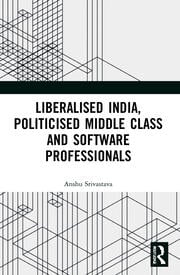
The middle classes in India are typically passive in activism, yet election strategies cater to their preferences. Anshu Srivastava’s Liberalised India, Politicised Middle Class and Software Professionals (published by Routledge in 2022) turns its analytic gaze onto these classes and their recent interest in politics. It is situated in a legacy of scholarship accessing spaces that have been, unlike disenfranchised communities, opaque to social science investigation. The author Anshu Srivastava, a political scientist, forwards the thesis that the new middle classes in India are not merely a consuming class as construed in post-liberalization discourses, but also a political category. Unlike the old middle class, members of the new middle class have a limited relationship to the public sector. Middle classes in the third world differ from their Euro-American counterparts since the former exist in relation to nationalistic movements. Srivastava captures a dilemma central to studying the Indian middle class: the tightrope between essentializing and homogenising it with reference to a global middle class.
The book results from a case study of software professionals in Noida from fieldwork conducted in 2014-15. Participants were asked to self-identify as middle class through surveys and interviews. The data was approached through an inductive lens. However, since the author admittedly attempts to understand specific sections of the middle class which “have remained unexplored” (p. xv), I wonder why she chose software professionals. Beneficiaries of economic liberalization since 1991 and known for their transnational mobility, this section is an established choice to study new middle-class subjectivities (Upadhya 2016).
The key problematic concerning this book is: what unites the middle classes for political action? The first two chapters make for a comprehensible introduction to the political economy of the middle class by contextualizing its rise—while traditionally it has been lacking in political consciousness, state involvement has been crucial to its creation. The third chapter examines the claim that software professionals are identified with popular imaginations of new India. It profiles the industry and its professionals. IT (Information Technology) employees consider themselves professionals rather than workers. Hence, they are reluctant to unionize and do not view their lack of work-life balance as a ‘labour issue.’ (p. 64) The figure of Narayan Murthy as embodying old middle-class values of austerity and self-sacrifice is interesting and may be read considering recent debate around his advice to young Indians to work 70 hours a week.
In terms of a unified political identity, the middle-class person is a consumer-citizen where the state is the producer. The book interrogates their values on matters of political mobilization like the ruling Bharatiya Janata Party, affirmative action, and cleanliness. These values abound in paradoxes—hostility towards the poor, but enthusiasm for anti-corruption. The anti-corruption movement of 2011 aligned with their goals towards state withdrawal from welfare and demand for state support in attracting capital. Anna Hazare as a no-nonsense character interested in result, not politics, appealed to them. Hazare mobilized technology which has been key to reviving the economy. The issues raised articulate the discourse of civic responsibility, leading to the success of the Aam Aadmi Party. In the final chapter on middle-class activism, Srivastava recounts some incidents of middle-class activism in Noida and Gurugram which demonstrate the salience of long-term engagement with a region. Middle-class issues manage to garner state attention and have reach till high-ranking legislators like the Chief Minister. The identity of the middle class thus emerges as modest and awaiting action by the state, with deep trust in democratic processes. The state steps in as an instrument to restructure its relationship with this class.
In the section on gender, women’s views are recorded on certain matters while men’s views on others. The analysis of women in the IT sector would have benefited from conceptual tools in relation to South Asia. Further, software professionals are a heterogenous group. If opinions differ based on gender, one wonders if there is variation in political activism based on whether interlocutors are migrants or natives to the National Capital Region.
The monograph, developed from an interest in perceptions of state democracy, governance and civil society, is not confined to political science. It engages with sociology and social anthropology to assess if political opinions have an impact on the electoral politics of India. Yet, an opportunity to effectively engage with theories of class was missed in the analysis which, to my surprise, excluded Citizenship Amendment Act (CAA) protests that took the shape of a movement in 2019-20. The concluding argument must be taken seriously: the political causes, be it environmentalism, corruption, feminism, etc. mobilizing the middle classes reflects class divide. Future research may consider how software professionals in India are unique as a middle-class demographic and how their subjectivities compare with IT professionals in other regions.
***
Meghna Roy is a Doctoral Research Fellow at the Department of Social Anthropology, University of Oslo.
References
Upadhya, Carol. 2016. Reengineering India: Work, Capital, and Class in an Offshore Economy. First edition. New Delhi, India: Oxford University Press.